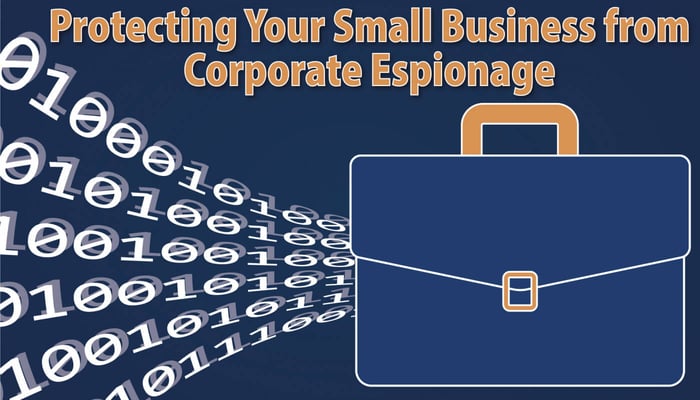So you’ve worked hard developing your business through the pandemic and have made it out the other side ready to expand, the last thing you expect to have to deal with now is corporate espionage. You know that starting a business takes a lot of effort, a lot of meetings, and a lot of paperwork. Long-term goals are discussed in strategy meetings, proprietary technology is used by technical teams, and cash flow is discussed during financial review meetings.
All these pieces of information could be damaging in a competitor's hands and could present a stumbling block to any up-and-coming business if used against you. Now we don’t want to alarm you, but if you invest enough in research and development, or have a lot of high tech assets, it is a good idea to protect this sensitive information from potential bad actors. Think about “what is corporate espionage as it pertains to my business?” This will give you a good jumping-off point to work out your vulnerabilities and where you should begin to improve security.
This article will go through a few measures you can take to protect your business against corporate espionage. First, we’ll talk about a few methods people could use to spy on your business to give you some idea of what you might be up against, then we’ll talk about a few techniques you can use to stop these spies in their tracks.
Corporate spying in the office
Live, in-person corporate spying takes two main forms, video surveillance, and audio surveillance. Corporate spies can use hidden listening devices or hidden cameras in the office. A small hidden microphone can be used to record important meetings or transmit live to your competitors in real-time. Similarly, some hidden cameras can record to their internal memory or broadcast live video.
Audio Surveillance
Hidden voice recorders are tiny and extremely difficult to find. They can be disguised as the kind of regular office item that anyone might carry with them, or taped under a desk and left to record when the spy is not there.
A key feature of some of these recording devices is that they are voice-activated. This means that they only record when someone is making noise nearby. This prolongs their battery life and makes their internal memory last longer, some of these listening devices can last for months on a single charge this way. It also lets the person doing the spying leave the recorder in an office and know meetings will be recorded without that person having to press record on the device.
Check out the Pro USB flash drive audio recorder, 16-hour voice-activated recorder pen, and the Micro stick voice-activated recorder for a more detailed look at how these recorders work.
Broadly, we divide audio surveillance devices into two types, passive and active. Passive voice recorders record to internal memory whereas active voice recorders broadcast in real-time. Live transmission might sound more sophisticated but it also makes it easier to find the bug. More on that later…
Video Surveillance
Hidden cameras have gotten so small these days they can be disguised as nearly anything. Pot plants, office equipment, the classic buttonhole camera, even a bowl of potpourri; we’ve heard of tiny spy cameras hidden in nearly everything.
Generally, people engaged in corporate espionage use different types of cameras for different purposes. Smaller, wearable cameras can be used to easily spy on documents or content displayed on monitors around the office. They’re useful because they are so mobile and often face the way the person is facing.
Larger spy cameras tend to be disguised as larger office appliances like clocks or power banks so are far less mobile and tend to get a more limited view of a room. They are a little more limited when applied to corporate espionage than wearable cameras because of this but they possess two advantages. Firstly they plug in so they won’t run out of battery when recording a meeting. Secondly, larger units are more likely to be able to transmit live, which brings us back around to…
Detecting spy equipment in the office
RF detectors
We mentioned earlier that while it might seem that transmitting live audio or video is useful, it also makes the bugs easier to find. The reason for this is radiofrequency (RF) detectors. When a wireless device transmits a signal, like an audio or video signal, it does so using radio waves. These radio waves can be detected by a bug detector, a small, battery-powered, handheld device, usually with an antenna that beeps or flashes when it senses radio waves nearby.
To sweep a room for bugs, just turn up the sensitivity on the bug detector and turn off all other sources of radio waves in a room such as mobile phones and wireless routers and pass the antenna near likely hidden cameras or listening devices. If the device is transmitting live then the detector will flash or beep when it gets near the device and you can turn down the sensitivity to pinpoint the location of the bug. You can also use the detector to find wearable bugs by passing it over someone's body.
Hidden camera detectors
So that's active recording devices covered, but what about passive? While passive voice recorders must be found by visual inspection, passive hidden cameras can be found with a hidden camera detector.
These are compact and easy-to-use devices that have a bunch of LEDs arranged around an eyepiece. Press the button on the detector and look through the eyepiece. The eyepiece contains a filter that makes it possible to see the reflection of the lens of a hidden camera through it. For best results, turn off the lights in the room before conducting your sweep.
Any camera lens, even a tiny pinpoint lens will be revealed by a tiny, red glowing dot in the viewfinder. This is because the light from the LEDs bounces off the lens off the CCD and CMOS material behind the lens and back through the viewfinder into your eye.
Audio jammers
While passive voice recorders are nearly impossible to find except by physical examination, they can be interfered with using an audio jammer. These devices emit white noise constantly to drown out the sounds of a conversation. They work by emitting sound at every frequency to overload the microphone in a listening device.
When you are having a meeting where sensitive information is being discussed, switch on one of these and speak softly and you can be sure your conversation is not being recorded.
We hope you have found this rundown of corporate spying equipment which can be used for industrial espionage useful. Have a look at some of the surveillance equipment on this site for a better idea about how corporate spies can use these devices against your business and then look at some of the great ways they can be countered. Happy hunting!



